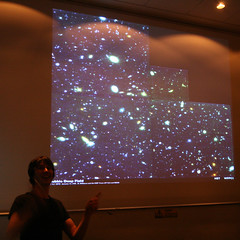 Image by Dave Pearson via FlickrProfessor Brian Cox stated on TV on the "Something for the weekend" program dated 13-03-2011, that "Science can be wrong," and in the case of how light travels and reacts in space, science has got it very wrong.
Image by Dave Pearson via FlickrProfessor Brian Cox stated on TV on the "Something for the weekend" program dated 13-03-2011, that "Science can be wrong," and in the case of how light travels and reacts in space, science has got it very wrong.When we look directly at a star (i.e. our sun) we are looking at it as it is at that moment not as it was when the rays from it that are hitting us left it.
Scientists wrongly assume that when we look at our sun or distant stars that we are seeing them as they were at the time it takes light to reach us from that particular star, but you have to remember that stars are spherical in shape and any light projected from them is emitted in all directions, dispersing and spreading into space the further it travels.
Light is released from the sphere it does not travel in the shape of the object it leaves, or take the object with it.
If we look face on at a movie projector we see a bright light, not the image it will project on to the screen, and if we sit at the side of the light it projects we see the ray from that source, not the image. It is only when we watch from behind the light source as it hits a screen that we see the image it is projecting.
We need something to catch the light rays and reflect the image back to us.
It is the same principle with stars, and as I stated, stars are spherical, so we are observing them from the front, the side and from behind, therefore if, as scientists assume, that light travels as the image it leaves, how can we see that image without a screen to catch it?
When the projector is switched on you see it flicker into life, then the bright light follows until it is switched off, then it fades and disappears like a dying star and the rays from it cease to show any distinguishable shape or form because you need the source of light to be present for the image to be portrayed properly.
Stars are only visible to us because the heat source that generates the light is still present. We are seeing the star as it is with light radiating from it strongly at its source and the light that was released from it years ago is dispersing into space in all directions.
Another point I would like to bring to your attention is that the dying star grb090423 which is 13 billion years away from us, is dying now not 13 billion years ago as Professor Brian Cox and his associates assume.
During the lifetime of that star the universe has moved, therefore if their theory were true we would be able to see the image of that star in another part of the sky as it formed, then in another point in the sky as it lived, with its death throes we are observing now in the position it is now.
Also if it took us 13 billion years to reach that star, according to their theory it would then be 26 billion years old plus the time it took to form and live, or 13 billion years older than it was when we left our planet, and if it was in its dying stages 13 billion years ago there would be nothing left when we reached the point in the universe that it originated.
We see stars and galaxies in various stages of birth and death light years away from us and each stage is happening out there now or we would not be able to observe them as they are. In some cases there would be nothing to focus on, as in others there would be no solid matter to bounce radar signals off.
They also contradict themselves when they look at stars and see planets circling around them and tell us that it is happening now, make assumptions of what it will be like there, when if the therory they work on were true, what they are observing would have happened light years ago and what is happening at that spot in the universe will be completely different, making their assumptions and the idea of venturing to distant stars irrelevant as we could never be sure of what we would find when we got there.
Professor Brian Cox constantly says "we think" when he is referring to his theories on the universe and that is exactly what we have to go on most of the time, THEORIES.
Theories have all too often been proved wrong when new discoveries are made or when we advance our methods of discovery and until we realize that what we see out there is happening now, our scientists will be coming to the wrong conclusions when calculating the ifs and buts of our beginnings.
While I agree with most of Brian Cox's theories I will have to disagree with him on his assumptions on how light travels from the stars.


No comments:
Post a Comment